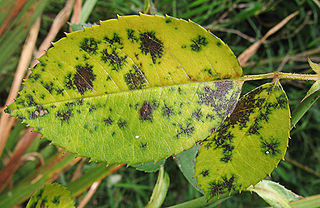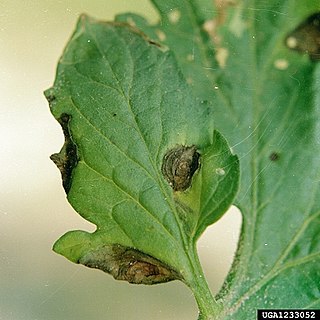
A leaf spot is a limited, discoloured, diseased area of a leaf that is caused by fungal, bacterial or viral plant diseases, or by injuries from nematodes, insects, environmental factors, toxicity or herbicides. These discoloured spots or lesions often have a centre of necrosis. Symptoms can overlap across causal agents, however differing signs and symptoms of certain pathogens can lead to the diagnosis of the type of leaf spot disease. Prolonged wet and humid conditions promote leaf spot disease and most pathogens are spread by wind, splashing rain or irrigation that carry the disease to other leaves.
Pyrenophora teres is a necrotrophic fungal pathogen of some plant species, the most significant of which are economically important agricultural crops such as barley. Toxins include aspergillomarasmine A and related compounds.

Diplocarpon rosae is a fungus that creates the rose black spot disease. Because it was observed by people of various countries around the same time, the nomenclature for the fungus varied with about 25 different names. The asexual stage is now known to be Marssonina rosae, while the sexual and most common stage is known as Diplocarpon rosae.

Venturia inaequalis is an ascomycete fungus that causes the apple scab disease.

Ophiostoma ulmi is a species of fungus in the family Ophiostomataceae. It is one of the causative agents of Dutch elm disease. It was first described under the name Graphium ulmi, and later transferred to the genus Ophiostoma.
Powdery mildew is a fungal disease of barley caused by Blumeria graminis f. sp. hordei. The disease has a worldwide distribution and is most damaging in cool, wet climates. The host range of the form species hordei is restricted to barley and other Hordeum species.
Alternaria triticina is a fungal plant pathogen that causes leaf blight on wheat. A. triticina is responsible for the largest leaf blight issue in wheat and also causes disease in other major cereal grain crops. It was first identified in India in 1962 and still causes significant yield loss to wheat crops on the Indian subcontinent. The disease is caused by a fungal pathogen and causes necrotic leaf lesions and in severe cases shriveling of the leaves.

Botryosphaeria ribis is a fungal plant pathogen that infects many trees causing cankers, dieback and death.

Diplocarpon earlianum is a species of fungus that causes disease in strawberry plants called strawberry leaf scorch. The disease overwinters in plant debris and infects strawberry plants during the spring season when it is wet. The five main methods to reduce strawberry leaf scorch include: irrigation techniques, crop rotation, planting resistant and disease-free seeds, fungicide use, and sanitation measures. Control of strawberry leaf scorch is important because it is responsible for the majority of disease in strawberries. Diplocarpon earliana affects the fruit quality and yield of the strawberry crop. Losses range from negligible to severe depending on numerous epidemiological factors including cultivar susceptibility, type of cropping system, and weather conditions

Ascochyta is a genus of ascomycete fungi, containing several species that are pathogenic to plants, particularly cereal crops. The taxonomy of this genus is still incomplete. The genus was first described in 1830 by Marie-Anne Libert, who regarded the spores as minute asci and the cell contents as spherical spores. Numerous revisions to the members of the genus and its description were made for the next several years. Species that are plant pathogenic on cereals include, A. hordei, A. graminea, A. sorghi, A. tritici. Symptoms are usually elliptical spots that are initially chlorotic and later become a necrotic brown. Management includes fungicide applications and sanitation of diseased plant tissue debris.
Cercospora arachidicola is a fungal ascomycete plant pathogen that causes early leaf spot of peanut. Peanuts originated in South America and are cultivated globally in warm, temperate and tropical regions.
Mycosphaerella angulata is a fungal plant pathogen infecting muscadine grapes. This pathogen causes the common disease angular leaf spot. Mycosphaerella angulate is an ascomycete in the fungi kingdom.

Alternaria solani is a fungal pathogen that produces a disease in tomato and potato plants called early blight. The pathogen produces distinctive "bullseye" patterned leaf spots and can also cause stem lesions and fruit rot on tomato and tuber blight on potato. Despite the name "early," foliar symptoms usually occur on older leaves. If uncontrolled, early blight can cause significant yield reductions. Primary methods of controlling this disease include preventing long periods of wetness on leaf surfaces and applying fungicides. Early blight can also be caused by Alternaria tomatophila, which is more virulent on stems and leaves of tomato plants than Alternaria solani.

Didymella bryoniae, syn. Mycosphaerella melonis, is an ascomycete fungal plant pathogen that causes gummy stem blight on the family Cucurbitaceae, which includes cantaloupe, cucumber, muskmelon and watermelon plants. The anamorph/asexual stage for this fungus is called Phoma cucurbitacearum. When this pathogen infects the fruit of cucurbits it is called black rot.

Elsinoë ampelina is a plant pathogen, which is the causal agent of anthracnose on grape.

Southern corn leaf blight (SCLB) is a fungal disease of maize caused by the plant pathogen Bipolaris maydis.

Common spot of strawberry is one of the most common and widespread diseases afflicting the strawberry. Common spot of strawberry is caused by the fungus Mycosphaerella fragariae. Symptoms of this disease first appear as circular, dark purple spots on the leaf surface. Mycosphaerella fragariae is very host-specific and only infects strawberry.
Botryotinia polyblastis is a fungal plant pathogen that causes Narcissus Fire of daffodils, genus Narcissus.

Alternaria leaf spot or Alternaria leaf blight are a group of fungal diseases in plants, that have a variety of hosts. The diseases infects common garden plants, such as cabbage, and are caused by several closely related species of fungi. Some of these fungal species target specific plants, while others have been known to target plant families. One commercially relevant plant genus that can be affected by Alternaria Leaf Spot is Brassica, as the cosmetic issues caused by symptomatic lesions can lead to rejection of crops by distributors and buyers. When certain crops such as cauliflower and broccoli are infected, the heads deteriorate and there is a complete loss of marketability. Secondary soft-rotting organisms can infect stored cabbage that has been affected by Alternaria Leaf Spot by entering through symptomatic lesions. Alternaria Leaf Spot diseases that affect Brassica species are caused by the pathogens Alternaria brassicae and Alternaria brassicicola.
Phyllachora maydis is a plant pathogen causing ascomycete diseases in maize/corn, and is more commonly referred to as tar spot. Identified by the distinctive development of stroma, this pathogen in itself is of little economic importance in the production of corn. However, the accompanying fungal infection of Monographella maydis, identified by “fish-eye” lesions, was claimed to cause significant foliar damage and subsequently yield reduction. As of 2021 there is insufficient information about this pathogen and its management.














